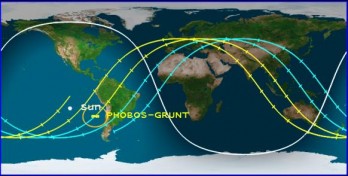Were two Iridium satellites hit by space junk?
Engineers are puzzling over the release of debris from two separate Iridium satellites last year, with each even suggesting the satellites were hit by very small pieces of space junk.
The U.S. Joint Space Operations Center detected 10 pieces of debris from the Iridium 47 satellite June 7, 2014. Some of the objects flew away from Iridium 47 at up to 80 meters per second — nearly 180 mph — into orbits almost 200 miles above the satellite, suggesting an explosion or collision triggered their creation. Another Iridium spacecraft — Iridium 91 — produced four debris fragments Nov. 30, according to U.S. military tracking data. “In contrast to the previous Iridium breakup, however, these pieces were produced with minimal delta velocity and remained in the vicinity to the parent spacecraft for some time,” NASA officials wrote.
In both cases, the satellites showed no signs of a breakup and remain operational, according to Iridium Communications, a Virginia-based company that uses a fleet of spacecraft nearly 500 miles above Earth for mobile voice and data services.
Engineers are puzzling over the release of debris from two separate Iridium satellites last year, with each even suggesting the satellites were hit by very small pieces of space junk.
The U.S. Joint Space Operations Center detected 10 pieces of debris from the Iridium 47 satellite June 7, 2014. Some of the objects flew away from Iridium 47 at up to 80 meters per second — nearly 180 mph — into orbits almost 200 miles above the satellite, suggesting an explosion or collision triggered their creation. Another Iridium spacecraft — Iridium 91 — produced four debris fragments Nov. 30, according to U.S. military tracking data. “In contrast to the previous Iridium breakup, however, these pieces were produced with minimal delta velocity and remained in the vicinity to the parent spacecraft for some time,” NASA officials wrote.
In both cases, the satellites showed no signs of a breakup and remain operational, according to Iridium Communications, a Virginia-based company that uses a fleet of spacecraft nearly 500 miles above Earth for mobile voice and data services.

